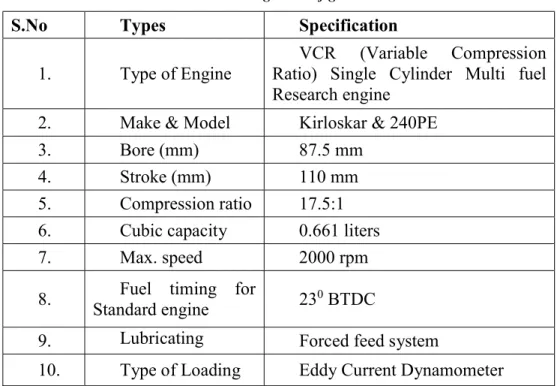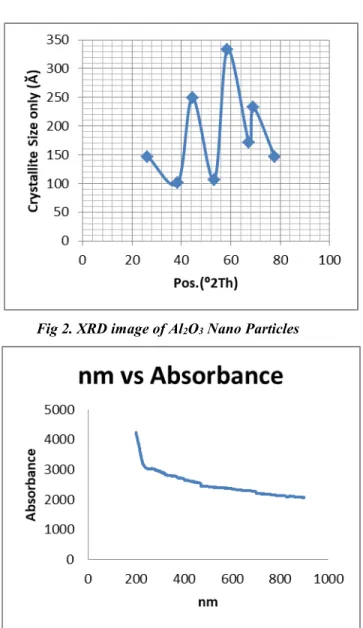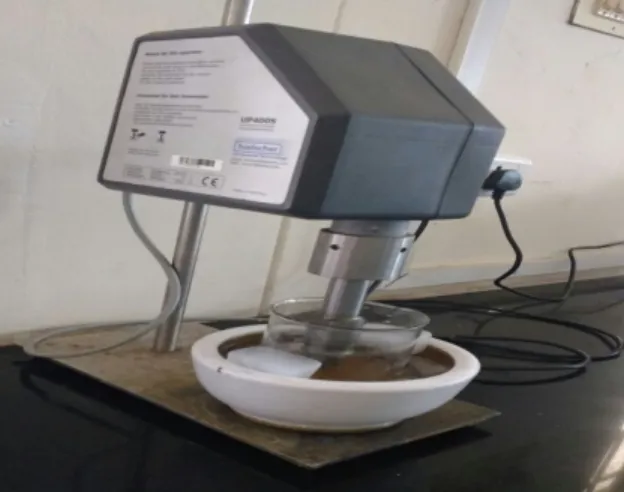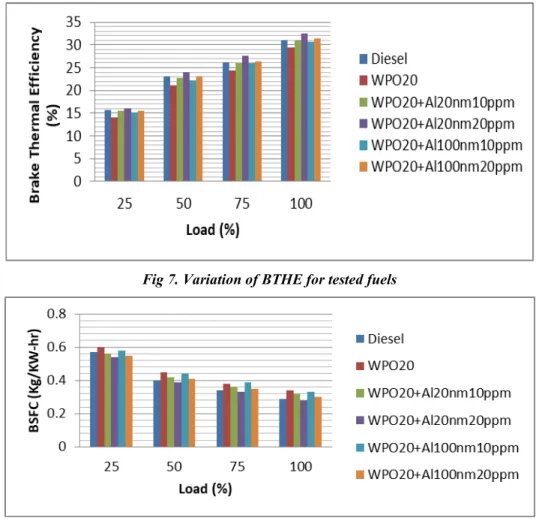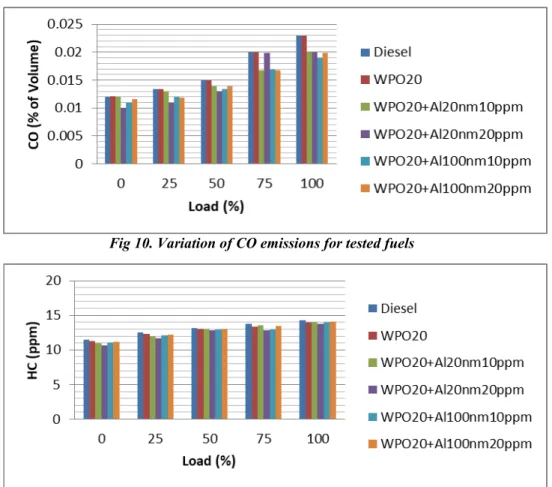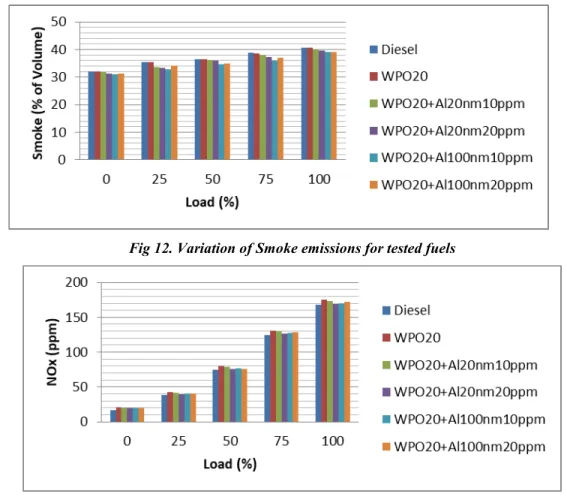I
NTERNATIONALR
ESEARCHJ
OURNALOFM
ULTIDISCIPLINARYT
ECHNOVATION(IRJMT)http://www.mapletreejournals.com/index.php/IRJMT Received 18 January 2019 ISSN xxxx-xxxx Accepted 23 January 2019 2019; 1(1); 70-79 Published online 25 January 2019
Experimental studies on Diesel Engine using Aluminium Nano
Particles as Additives
S.N.Shreenivasan1*, C.Chinnasamy2
1*PG Student, Department of Mechanical Engineering, SNS College of Technology, Coimbatore, Tamilnadu, India. 2Assistant professor, Department of Mechanical Engineering, SNS College of Technology, Coimbatore, Tamilnadu,
India.
*Corresponding author E-Mail ID: shreenivasan444@gmail.com, Mobile: 9597092849
ABSTRACT
In this study an experimental investigation has been carried out on diesel engine to understand the engine behaviour with respect to its performance and emission characteristics while using Aluminium oxide (Al2O3) Nano particle as additive with a blend of diesel and biodiesel sourced
from Waste Plastic Oil (WPO). The Alumina Nano particles are characterized by X- ray diffraction (XRD), Fourier transform infrared spectroscopy (FTIR) analysis, UV-Vis Spectroscopy and Zeta Potential Analysis. The alumina Nano particles are blended with Waste Plastic Oil in the mass fractions of 10 and 20 ppm using an Ultrasonicator. The experiments are carried out in single cylinder four stroke Variable Compression Ratio diesel engine by varying the load using eddy current dynamometer. The experimental results reveal that there is a significant improvement in the performance characteristics like Brake Thermal Efficiency and Brake Specific Fuel Consumption and considerable reduction in the emission constituents like carbon Monoxide (CO) and Unburned Hydrocarbon (HC) and smoke but in turn increase in Nitric oxide (NOx) emissions were observed.
Keywords: Diesel engine, Nano additives, Waste Plastic Oil.
1. INTRODUCTION
The reason why diesel fuel consumed much higher than petrol all over the world is that the diesel powered engines have less fuel consumption, reliability and high brake thermal efficiency due to its high compression ratio operation. But on the other hand, the diesel engine exhaust may become one of the major sources of air pollution in nearby future. Everyday increase in the use of diesel engine powered vehicles increases the pollution and as a result diesel powered vehicles are banned to protect human beings from environmental hazards in major cities across the country. The applications of diesel powered engines increases day by day with respect to population of the country which results in lack of availability of diesel, due to which the prices of diesel fuel are revised very frequently. Also the emission regulations are becoming more stringent as and when it is revised which promotes the researchers to find advancements in use of alternative fuels and concentrate more on emission reduction technologies. The use of alternative fuels like vegetable oil in diesel engine is a former concept which has been tried by the inventor of diesel engine Rudolf diesel. The biofuel powered engine produces less smoke, Carbon monoxide, particulate matter and unburned hydrocarbon emissions; on the other hand, it results in the formation of high flame temperatures inducing more NOx emissions during combustion. The reason behind the usage of biodiesel as alternative fuel by researchers is that it can be fueled directly in diesel engine without any hardware modifications. In addition, biodiesel has more oxygen molecules in its
molecular structure, which in turn improves the combustion characteristics of the engine. The use of injecting water into diesel engines is one of the technique to reduce NOx emissions. The water effectively reduces the peak flame temperature by absorbing heat that is released from combustion and thereby helps in reducing NOx emissions. Another method of injecting water into diesel engine is in the form of micrometer/nanometer-sized droplets which improves the combustion of fuels. Since the boiling point of water is less than diesel, water droplets present in the form of small emulsions in diesel fuel starts to vaporize under heated stage of engine. Such vaporization helps in improving the atomization of fuel, better evaporation rate and eventually improves the fuel–air mixing process. Nano emulsion is one of the method of emulsion which is formed by mixing its constituents smoothly. These emulsions are crystal clear and kinetically stable. The particle size in Nano emulsion is less than 100nm which are prepared by using less surfactant concentrations and in micro-emulsions the particle size and surfactant concentration is quite high. The micro-explosion phenomenon of Nano-sized water droplets in the diesel fuel accelerates the fuel evaporation rate and its mixing process with air and eventually helps in reducing the overall combustion duration.
Biodiesel is considered as the main alternative fuels for compression ignition engines, because of their properties such as rich oxygen content, higher kinematic viscosity, reduced smoke emission and diluted level of pollutants from the engine exhaust (Smoke, Carbon monoxide, particulate matter and unburned hydrocarbons). Biodiesel containing 10% oxygen content helps in better combustion of the fuel; on the other hand, it results in the formation of high local temperatures inducing more NOx emissions during combustion. When compared to petrol and diesel, a 12% hike in NOx emission is observed for biodiesel fuel. To control such NOx emissions many strategies have been followed by researchers around the countries such as biodiesel blends, engine modification, exhaust gas reduction techniques and alteration in fuel formulations. Among them, fuel formulation techniques are considered as the most beneficial way of controlling the level of pollutants at the engine exhaust. In continuation of such techniques, the addition of nano particles in biodiesel results in reducing the level of pollutants at the engine exhaust and enhancing the engine performance substantially. Nano particle blended test fuels show better thermal properties, due to the higher surface area to volume ratio of the nano particle, resulting in increased oxidation of hydrocarbons and acting as oxygen buffer against NO. A few experiments were conducted with nano particles as additives in both diesel and biodiesel fuels with significant reduction of exhaust emission and improved brake specific fuel consumption. An experimental investigation with cerium oxide nano particle as addition (at 20, 40 and 60 ppm (parts per million)) in Jatropha biodiesel fuel had shown significant NO reduction by 30% and hydrocarbon emissions by 40%, besides increased brake thermal efficiency by 1.5%. Experimental investigation conducted in a single-cylinder four stroke direct injection variable compression ratio diesel engine using diesel-biodieselethanol blends blended with cerium oxide nanoparticle at 25 ppm, resulted in drastic reduction of exhaust emissions such as hydrocarbon, nitric oxide and carbon monoxide. The addition of aluminium nano particle in diesel along with 3e6 % volume of water addition as fuel in a diesel engine shows reduced concentration of smoke and nitrous oxide with significant improvement in brake thermal efficiency. Basha and anand, drew attention of blending two nano particles namely alumina and CNT (dosing ratio of 25 and 50 ppm) in Jatropha biodiesel and found maximum reduction of NO by 23% for alumina and CNT blended Jatropha biodiesel. In continuation with significant NO reduction, the brake thermal efficiency of engine increases for alumina and cerium oxide blended Jatropha biodiesel along with smoke opacity reduction by 1.5%. From the literatures, the blending of two nano particles in biodiesel shows the most promising results for the performance and emission characteristics of the engine in particular NO emission compared to the individual addition of a nano particle. The present work aims at studying the engine behavior by fueling the diesel with Waste Plastic Oil biodiesel along with varying proportions of Aluminum oxide as Nano additives.
2. ENGINESETUP
The experimental setup consists of single cylinder four stroke VCR diesel engines. The detailed configuration of the engine used in this study is given in the table I.
Table1. Engine Configurations
S.No Types Specification
1. Type of Engine Ratio) Single Cylinder Multi fuel VCR (Variable Compression Research engine
2. Make & Model Kirloskar & 240PE
3. Bore (mm) 87.5 mm
4. Stroke (mm) 110 mm
5. Compression ratio 17.5:1 6. Cubic capacity 0.661 liters
7. Max. speed 2000 rpm
8. Standard engine Fuel timing for 230 BTDC
9. Lubricating
system Forced feed system
10. Type of Loading Eddy Current Dynamometer
The Engine Soft software is initially configured with input data’s like flow rate of air, fuel and cooling water, Calorific Value of the fuel, Density of the fuel and polytrophic index. The performance parameters like BSFC, BTHE, BP, mechanical efficiency are obtained through signals extracted through ECU and stored in the form of tables and plots hard disk. The exhaust emission pipe is connected with four gas analyzer and AVL make smoke meter in order to measure emission constituents like Carbon Monoxide (CO), Unburned Hydrocarbons (HC), NOx, CO2 and smoke. The graphical view of the experimental setup is shown as layout in figure 1.
3.CHARACTERIZATION OF NANO PARTICLES
The crystalline phase of Alumina Nano particles is determined by X-ray Diffraction and all the peaks obtained are shown in fig 2. Fourier transform infrared (FTIR) spectroscopy of Al2O3
Nano Particles was conducted to determine the presence of various functional groups. The FTIR spectra were measured in the wavenumber range of 1000–3500 cm−1 as shown in fig 5. In addition to these two analysis UV-Vis Spectroscopy analysis and Zeta Potential Analysis were also performed on the Al2O3 Nano Particles and their absorption or reflection spectroscopy are
analyzed along with electro kinetic potential in colloidal dispersions. The UV-Vis Spectroscopy results are depicted in fig 2, and the Zeta Potential analysis is shown in fig.4.
Fig 2. XRD image of Al2O3 Nano Particles
Fig 4. Zeta Potential Analysis of Al2O3 Nano Particles
Fig 5. FTIR Analysis of Al2O3 Nano Particles
4.ULTRASONICATION
The equipment used for mixing Biodiesel-diesel fuel with Aluminium oxide nanoparticles is an ultra-sonic shaker. The catalytic nanoparticle added with diesel is agitated for about 30 minutes with a fixed frequency rate in an Ultrasonicator to obtain a stable Nano fluid as shown in fig 6. In order to obtain better stability characteristics appropriate volume of surfactants are added with a reaction. The alumina Nano particles are blended with waste plastic oil in the mass fractions of 10 and 20 ppm. The Alumina Nano particles were stable in the biodiesel blend for more than 2 days under idle conditions.
5.RESULTS AND DISCUSSIONS 5.1 Performance Characteristics
The variations of Brake Thermal Efficiency are given in the fig. 7. From the results graph we infer that the Brake Thermal Efficiency of pure diesel is less than that of the BTE obtained from the blends of WPO20+Al20nm20ppm. This is considered as a greater advantage than a pure diesel. Also it can be noted that the BTE tends to increase with the increase in loads. Hence in terms of BTE rather than pure diesel and various proportions of bio diesel blends, the WPO20+Al20nm20ppm is very much effective in improving the BTE of the Diesel engine.
The variations of Brake Specific Fuel Consumption is given in the fig. 8. From the results we infer that the BSFC of pure diesel is greater than that of the BSFC obtained from the blends of WPO20+Al20nm20ppm. This is a positive aspect when compared with that of pure diesel. It can be noted that the BSFC decreases with the increase in loads. So for an advantageous result from the diesel engine, WPO20+Al20nm20ppm is better than pure diesel and other proportions of bio diesel blends.
Fig 7. Variation of BTHE for tested fuels
Fig 8. Variation of BSFC for tested fuels 5.2 Emission Characteristics
The Primary pollutants in CI engines are CO, Unburned HC, NOx and smoke. The various regions inside the combustion chamber in which CI engine emission constituents are shown in fig 10. The CO and HC is mainly formed in the outer flame region where the fuel mixture is lean due to which incomplete combustion or partial reaction of oxygen molecule occurs. NOx is generally formed by the reaction of Nitrogen present in the air with oxygen at high flame temperature.
The formation of NOx is directly proportional to Combustion Flame temperature inside the cylinder. The oxygen content in the biodiesel is higher than diesel. Hence more oxygen will react with Nitrogen resulting in Higher NOx concentration. The figure shows the various regions inside the combustion chamber where emission constituents are formed.
Fig 9. Regions of emission formation
With an addition of WPO20 the CO, HC emissions seems to decrease or remains the same with respect to diesel fuels. But with the addition of Nano additives the CO AND HC emissions along with the volume of smoke seems to decrease. This could be found throughout the varying load capacity of the diesel engine. This could be found in the fig, 10, fig. 11 and fig. 12 respectively. But we also find that the NOx emission doesn’t decrease but instead is found to be increasing with the addition of Nano particle to the blends and tends to increase with the increase in load with respect to diesel fuels as indicated in fig. 13.
Fig 10. Variation of CO emissions for tested fuels
Fig 12. Variation of Smoke emissions for tested fuels
Fig 13. Variation of NOx emissions for tested fuels
6. Conclusion
The following conclusions can be extracted by the experimental studies carried out on diesel engine using Waste Plastic Oil biodiesels and Alumina Nano particles as fuel:
1. The stability of Nano fluid in the biodiesel was maintained for more than 2 days under standard atmospheric conditions.
2. For the Blend of WPO 20 the Brake Thermal Efficiency increases and consumption of fuel is lower under all load conditions which is due to less heating value and higher viscosity of biodiesel.
3. When the Nano particles are blended with B20 the BSFC seem to reduce with slight increase in BTHE as the surface to volume ratio of added Nano particles are enhanced. 4. With an addition of WPO 20 the CO, HC and smoke emissions seem to decrease and NOx
emission seem to increase in comparison with diesel at all load conditions.
5. When Nano additives are added with Biodiesel CO emissions are reduced along with HC emissions and smoke and NOx decreases at lower loads but increases at higher loads. Reference
[1] Manzoore Elahi M. Soudagara and Nik-Nazri Nik-Ghazalia, “The effect of nano-additives in diesel-biodiesel fuel blends: A comprehensive review on stability, engine performance and emission characteristics”, Energy Conversion and Management 178, 2018.
[2] A. Prabu and R.B. Anand, “Emission control strategy by adding alumina and cerium oxide nano particle in biodiesel”, Journal of the Energy Institute 1-7, 2015.
[3] J. Sadhik Basha and R. B. Anand, “The influence of nano additive blended biodiesel fuels on the working characteristics of a diesel engine”, The Brazilian Society of Mechanical Sciences and Engineering 35, 2013.
[4] T. Shaafi and R. Velraj, “Influence of alumina nanoparticles, ethanol and isopropanol blend as additive with dieselesoybean biodiesel blend fuel: Combustion, engine performance and emissions”, Renewable Energy 80, 2015.
[5] C. Syed Aalam and C.G. Saravanan, “Experimental investigations on a CRDI system assisted diesel engine fuelled with aluminium oxide nanoparticles blended biodiesel”, Alexandria Engineering Journal 54, 2015.
[6] Ang F. Chen andM. Akmal Adzmi, “Combustion characteristics, engine performances and emissions of a diesel engine using nanoparticle-diesel fuel blends with aluminium oxide, carbon nanotubes and silicon oxide”, Energy Conversion and Management 171, 2018. [7] Jiaqiang E and Zhiqing Zhang, “Performance and emission evaluation of a marine diesel
engine fueled by water biodiesel-diesel emulsion blends with a fuel additive of a cerium oxide nanoparticle”, Energy Conversion and Management 169, 2018.
[8] Ahmed I. EL-Seesy and Hamdy Hassan, “Performance, combustion, and emission characteristics of a diesel engine fueled with Jatropha methyl ester and graphene oxide additives”, Energy Conversion and Management 166, 2018.
[9] Ahmed I. El-Seesy and Ali M.A. Attia, “The effect of Aluminum oxide nanoparticles addition with Jojoba methyl ester-diesel fuel blend on a diesel engine performance, combustion and emission characteristics”, Fuel 224, 2018.
[10]Ehsanollah Ettefaghi and Barat Ghobadian, “Bio-nano emulsion fuel based on biodegradable nanoparticles to improve diesel engines performance and reduce exhaust emissions”, Renewable Energy 291, 2018.
[11]Soner Gumus and Hakan Ozcan, “Aluminum oxide and copper oxide nanodiesel fuel properties and usage in a compression ignition engine”, Fuel 163, 2016.
[12]A.K. Hasannuddin and W.J. Yahya, “Nano-additives incorporated water in diesel emulsion fuel: Fuel properties, performance and emission characteristics assessment”, Energy Conversion and Management 169, 2018.
[13]S.S. Hoseini and G. Najafi, ” The effects of nanographene oxide additives on the performance and emission characteristics of diesel engines fuelled with Ailanthus altissima biodiesel”, Renewable Energy 198, 2018.
[14]Syed Javed and Y.V.V. Satyanarayana Murthy, “Effect of a zinc oxide nanoparticle fuel additive on the emission reduction of a hydrogen dual-fuelled engine with jatropha methyl ester biodiesel blends”, Journal of Cleaner Production 254, 2016.
[15]Mina Mehregan and Mohammad Moghiman, “Effects of nano-additives on pollutants emission and engine performance in a urea-SCR equipped diesel engine fueled with blended-biodiesel”, Fuel 222, 2018.
[16]G.R. Kannan and R. Karvembu, “Effect of metal based additive on performance emission and combustion characteristics of diesel engine fuelled with biodiesel”, Applied Energy 88, 2011.
[17]Rakhi N. Mehta and Mousumi Chakraborty, “Nanofuels: Combustion, engine performance and emissions”, Fuel 120, 2014.
[18]Mohamed Nour and Ahmed I. EL-Seesy, “Influence of Adding Aluminum Oxide Nanoparticles to Diesterol Blends on the Combustion and Exhaust Emission Characteristics of a Diesel Engine”, Experimental Thermal and Fluid Science 596, 2018. [19]Varatharaju Perumal and M. Ilangkumaran,” The influence of copper oxide nano particle
added pongamia methyl ester biodiesel on the performance, combustion and emission of a diesel engine”, Fuel 232, 2018.
[20]T.Shaafi and K.Sairam, “Effect of dispersion of various nanoadditives on the performance and emission characteristics of a CI engine fuelled with diesel, biodiesel and blends—A review”, Renewable and Sustainable Energy Reviews 49, 2015.
[21]K. Vinukumar and A. Azhagurajan, “Biodiesel with nano additives from coconut shell for decreasing emissions in diesel engines”, Fuel 222, 2018.
[22] E. Russo and J.G.M. Kuerten, “Delay of biomass pyrolysis by gas–particle interaction”, Journal of Analytical and Applied Pyrolysis 110, 2014.
[23]Raquel Escrivani Guedes and Aderval S. Luna, “Operating parameters for bio-oil production in biomass pyrolysis: A Review”, Journal of Analytical and Applied Pyrolysis 213, 2017.
[24]Sadegh Papari and Kelly Hawboldt, “A review on condensing system for biomass pyrolysis process”, Fuel Processing Technology 180, 2018.
[25]Zhiwen Chen and Mingfeng Wang, “Pyrolysis of Torrefied Biomass”, Trends in Biotechnology 142, 2018.
